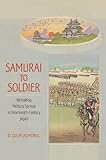Samurai to Soldier : Remaking Military Service in Nineteenth-Century Japan / D. Colin Jaundrill.
Material type: TextSeries: Studies of the Weatherhead East Asian Institute, Columbia UniversityPublisher: Ithaca, NY : Cornell University Press, [2016]Copyright date: ©2016Description: 1 online resource (248 p.) : 14 halftones, 1 map, 1 tableContent type:
TextSeries: Studies of the Weatherhead East Asian Institute, Columbia UniversityPublisher: Ithaca, NY : Cornell University Press, [2016]Copyright date: ©2016Description: 1 online resource (248 p.) : 14 halftones, 1 map, 1 tableContent type: - 9781501706097
- 355.0095209034 23
- DS838.5 .J38 2017
- online - DeGruyter
| Item type | Current library | Call number | URL | Status | Notes | Barcode | |
|---|---|---|---|---|---|---|---|
 eBook
eBook
|
Biblioteca "Angelicum" Pont. Univ. S.Tommaso d'Aquino Nuvola online | online - DeGruyter (Browse shelf(Opens below)) | Online access | Not for loan (Accesso limitato) | Accesso per gli utenti autorizzati / Access for authorized users | (dgr)9781501706097 |
Browsing Biblioteca "Angelicum" Pont. Univ. S.Tommaso d'Aquino shelves, Shelving location: Nuvola online Close shelf browser (Hides shelf browser)

|

|

|

|

|

|

|
||
| online - DeGruyter Imagining a Greater Germany : Republican Nationalism and the Idea of Anschluss / | online - DeGruyter Moral Commerce : Quakers and the Transatlantic Boycott of the Slave Labor Economy / | online - DeGruyter Hard Sell : Work and Resistance in Retail Chains / | online - DeGruyter Samurai to Soldier : Remaking Military Service in Nineteenth-Century Japan / | online - DeGruyter My Nuclear Nightmare : Leading Japan through the Fukushima Disaster to a Nuclear-Free Future / | online - DeGruyter Anthropologies of Unemployment : New Perspectives on Work and Its Absence / | online - DeGruyter Community Architect : The Life and Vision of Clarence S. Stein / |
Frontmatter -- Contents -- List of Illustrations -- Acknowledgments -- Introduction -- 1. The Rise of “Western” Musketry, 1841–1860 -- 2. Rising Tensions and Renewed Reform, 1860–1866 -- 3. The Drives to Build a Federal Army, 1866–1872 -- 4. Instituting Universal Military Service, 1873–1876 -- 5. Dress Rehearsal: The Satsuma Rebellion, 1877 -- 6. Organizational Reform and the Creation of the Serviceman, 1878–1894 -- Conclusion -- Glossary -- Notes -- Bibliography -- Index
restricted access online access with authorization star
http://purl.org/coar/access_right/c_16ec
In Samurai to Soldier, D. Colin Jaundrill rewrites the military history of nineteenth-century Japan. In fifty years spanning the collapse of the Tokugawa shogunate and the rise of the Meiji nation-state, conscripts supplanted warriors as Japan’s principal arms-bearers. The most common version of this story suggests that the Meiji institution of compulsory military service was the foundation of Japan’s efforts to save itself from the imperial ambitions of the West and set the country on the path to great power status. Jaundrill argues, to the contrary, that the conscript army of the Meiji period was the culmination—and not the beginning—of a long process of experimentation with military organization and technology. Jaundrill traces the radical changes to Japanese military institutions, as well as the on-field consequences of military reforms in his accounts of the Boshin War (1868–1869) and the Satsuma Rebellions of 1877. He shows how pre-1868 developments laid the foundations for the army that would secure Japan’s Asian empire.
Mode of access: Internet via World Wide Web.
In English.
Description based on online resource; title from PDF title page (publisher's Web site, viewed 26. Apr 2024)


